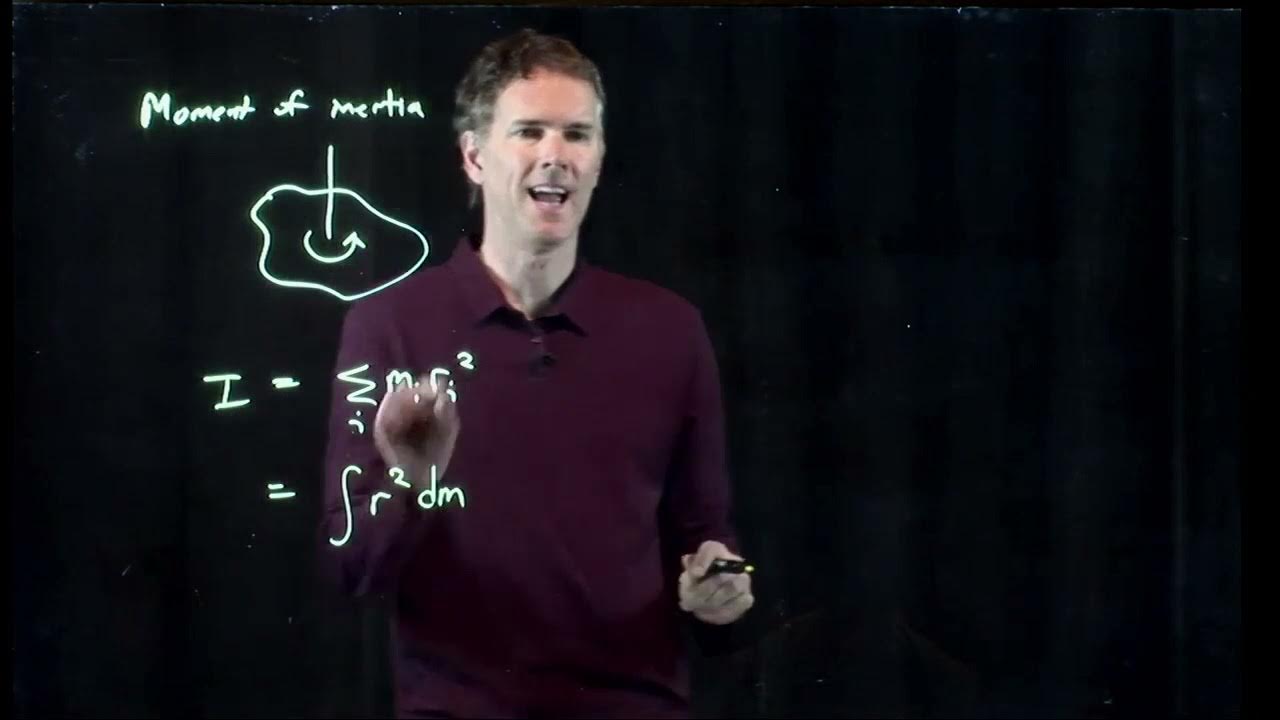What is a Moment?
TLDRThe video script delves into the concept of the moment of a force in engineering, explaining its significance in causing rotation about a point or axis. It introduces the scalar product formula for calculating moment (force multiplied by the perpendicular distance) and the vector formulation using cross products. The right-hand rule is highlighted for visualizing the direction of the moment vector. The principle of moments, or d'Alembert's theorem, is also discussed, showing how a force's moment can be decomposed into components for easier calculation. The content is aimed at engineering students, providing a foundational understanding of moments and their applications in various motion scenarios.
Takeaways
- 🌟 The moment of a force is a measure of its tendency to cause rotation about a given point or axis.
- 🔢 It is quantified as the scalar product of the force (F) and the perpendicular distance (D) between the point of rotation and the force, also known as the moment arm.
- 📈 The direction of the moment vector can be determined using the right-hand rule, which involves pointing fingers from the axis of rotation to the force and then curling the fingers to indicate the direction of rotation.
- 🚁 An aircraft's rotation is achieved through control surfaces like the elevator, which generates a force not in line with the center of gravity, causing an offset moment.
- 📚 The vector formulation of the moment of a force is given by M = R × F, where M is the moment, R is the position vector, and F is the force vector, with the cross product indicating the vector nature of the result.
- 🔄 The cross product in the vector formulation has a significant detail: R × F does not equal F × R, meaning the order of the vectors matters and leads to different directions for the resulting moment.
- 🔍 The principle of moments, also known as d'Alembert's principle, relates the moment of a force to the moments of its component forces, allowing for the calculation of the moment when the force is decomposed into different components.
- 🎯 The moment of a force can be calculated as the sum of the individual moments caused by each component of the force.
- 🛠️ Understanding moments is crucial in engineering as they are involved in various types of motion, including the rotation seen in machinery and structures.
- 🎓 Practicing calculating moments and solving problems involving them will lead to a deeper understanding and mastery of these concepts throughout an engineering education.
- 📈 The concepts of moments, both in scalar and vector forms, are fundamental to analyzing and designing systems that involve rotational motion.
Q & A
What is the moment of a force?
-The moment of a force, also known as torque, is a measure of the tendency of a force to cause rotation about a given point or axis. It is quantified as the scalar product of the force and the perpendicular distance (moment arm) between the point of rotation and the force.
How is the direction of a moment vector determined?
-The direction of a moment vector can be determined using the right-hand rule. By pointing your fingers from the axis of rotation to the force along the moment arm, and then curling your fingers in the direction of the force, your thumb will point in the direction of the moment vector.
What is the vector formulation of the moment of a force?
-The vector formulation of the moment of a force is given by M = R x F, where M is the moment vector, R is the position vector from the axis of rotation to the point of application of the force, and F is the force vector. The 'x' denotes the vector cross product.
Why is the order of the terms in the cross product important?
-The order of the terms in the cross product is important because R x F does not equal F x R. The resulting vectors will have the same magnitude but different directions, which affects the direction of the induced rotation.
What is the principle of moments or Varignon's theorem?
-The principle of moments, also known as Varignon's theorem, states that the moment of a force is equal to the sum of the moments of the force's components. This allows for the decomposition of a force into components and the calculation of their individual moments about a point or axis.
How does Newton's second law relate to motion?
-Newton's second law, which states that force equals mass times acceleration (F = ma), describes the relationship between force, mass, and acceleration. It explains how a force can push or pull an object into motion, translating in the direction of the applied force.
What is the difference between translation and rotation in motion?
-Translation is the motion of an object where all parts of the object move in the same direction and by the same distance, while rotation is the motion where an object turns about an axis, with each point of the object moving in a circle around that axis.
How does an aircraft achieve pitch up and down?
-An aircraft achieves pitch up and down through control surfaces such as the elevator, which generates a force that is not in line with the center of gravity. This offset force causes the aircraft to rotate about its center of gravity.
What is the significance of the perpendicular distance (moment arm) in calculating the moment of a force?
-The moment arm, which is the perpendicular distance between the force and the axis of rotation, is significant in calculating the moment of a force because it affects the magnitude of the rotation induced by the force. A longer moment arm for the same force will result in a greater moment and thus a greater tendency to rotate.
How can the principle of moments be applied in solving engineering problems?
-The principle of moments can be applied in engineering problems by decomposing a force into its components and calculating the individual moments of each component. This allows engineers to analyze the combined effect of multiple forces on an object's rotation around a point or axis.
What is the relationship between the scalar and vector formulations of a moment?
-In the scalar formulation, the moment is calculated as the product of the force and the perpendicular distance (moment arm). In the vector formulation, the moment is represented as the cross product of the position vector and the force vector. Both formulations describe the same physical concept but use different mathematical representations.
Outlines
🌪️ Introduction to Moments in Engineering
This paragraph introduces the concept of the moment of a force, a critical term in engineering. It explains that while forces can cause translational motion, they can also induce rotational motion, such as in wheels of vehicles or vinyl records. The moment of a force is the tendency for an object to rotate around an axis, quantified by the scalar product of the force and the perpendicular distance (moment arm) from the axis of rotation. The direction of the moment vector is determined using the right-hand rule, which involves pointing fingers from the axis of rotation to the force and curling the fingers to indicate the direction of rotation. The paragraph concludes by mentioning the vector formulation of the moment, which involves the cross product of the position vector and the force vector.
📐 Vector Formulation and Calculating Moments
This paragraph delves into the vector formulation of the moment of a force, emphasizing the use of the cross product. It clarifies that the position vector in the vector formulation does not need to be perpendicular to the force; it can be any vector from the axis of rotation to the line of action of the force. The paragraph highlights the difference between scalar and vector multiplication, noting that the order matters in cross products. It introduces the principle of moments, or d'Alembert's principle, which relates the moment of a force to the moments of its components. The summary encourages practice in calculating moments for better understanding and application in engineering problems.
Mindmap
Keywords
💡Moment of a Force
💡Rotation
💡Center of Gravity
💡Control Surfaces
💡Scalar Product
💡Moment Arm
💡Right Hand Rule
💡Vector Cross Product
💡Principle of Moments
💡Perpendicular Distance
💡Static Equilibrium
Highlights
The concept of 'moment of a force' is introduced, which is crucial in understanding rotational motion.
Moment is related to the translation motion described by Newton's second law (F=ma).
Rotation around an axis is a common type of motion in everyday life, such as in wheels and vinyl records.
An aircraft's rotation is achieved through control surfaces like the elevator, which generates an offset force.
The moment of a force is proportional to the force's magnitude and the perpendicular distance (moment arm) from the axis of rotation.
Moment of a force is a vector quantity, and its direction can be determined using the right-hand rule.
The scalar product (dot product) is used to quantify the moment of a force in its simplest form.
The vector formulation of the moment of a force involves the cross product of the position vector and the force vector.
The order of the cross product matters, unlike scalar multiplication, which is commutative.
The principle of moments (or d'Alembert's principle) relates the moment of a force to the moments of its individual components.
The moment of a force can be calculated as the sum of the moments of its decomposed components.
Understanding moments is essential for solving engineering problems involving rotational dynamics.
The concept of moment is not only theoretical but has practical applications in various engineering fields.
The use of calculus, specifically the cross product, is highlighted in vector formulation of moments.
The right-hand rule provides an intuitive method for visualizing the direction of the moment vector.
The moment of a force is a fundamental concept that will become second nature with practice in engineering studies.
Transcripts
Browse More Related Video

Moment of a Force | Mechanics Statics | (Learn to solve any question)

Moments, Torque, Toppling & Couples - GCSE & A-level Physics (full version)

The Principle of Moments - A Level Physics

torque explained

Understanding the Area Moment of Inertia

Moment of Inertia | Physics with Professor Matt Anderson | M12-05
5.0 / 5 (0 votes)
Thanks for rating: